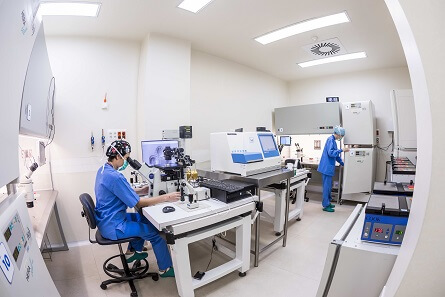

Pre-Implantation Genetic Testing For Monogenic Diseases (PGT-M) and Structural Arrangements (PGT-SR) detect specific genetic diseases and chromosomal abnormalities in embryos. It is recommended for certain patient groups to improve the chances of a successful healthy pregnancy.


Pre-Implantation Genetic Testing for Monogenic Diseases (PGT-M) or Chromosomal Structural Rearrangements (PGT-SR) (formerly known as single-gene or chromosomal PGD) detect specific genetic and chromosomal alterations in embryos. It is suitable for couples where one or both partners are known carriers of serious genetic conditions or chromosomal structural rearrangements (known as a translocation) who want to prevent their offspring from inheriting a condition or chromosomal imbalance.
RESULTS
Over the last 30 years, IVI has helped more than 250,000 dreams come true.
CARE
97% of our patients recommend IVI. We’re with you at every stage of your treatment, providing support and care.
TECHNOLOGY
IVI has a worldwide reputation for innovative research and has developed and patented pioneering techniques and technologies.
EXPERTISE
IVI is one of the largest fertility treatment providers in the world, with more than 75 clinics in 9 countries.
PGT-M is suitable for couples where one or both partner(s) are carriers of a known monogenic disease, or have a serious condition themselves, and are concerned about transmitting this condition to their baby. While the most common include cystic fibrosis and sickle cell anaemia, PGT-M can also be used to identify genetic conditions that are more rare. There is a list of conditions for which PGT-M is approved and it is regulated by the Human Fertilisation & Embryology Authority (HFEA). During PGT-M, molecular diagnosis is used to confirm whether an embryo will be affected by a specific disease. PGT-SR is suitable for carriers of chromosomal abnormalities (translocations). Although it’s estimated that 1 in every 500 people is a carrier of a translocation, carriers are normally healthy and often unaware until they try to have children. Being a carrier means there is a higher risk of producing abnormal embryos, which can make it difficult to conceive. Through PGT-SR, cytogenetic molecular diagnosis allows normal or balanced embryos to be identified by their chromosomal arrangements.
The purpose of PGT is to analyse embryos following in vitro fertilisation (IVF) to assess and identify the healthiest embryos which are free of any potentially harmful abnormalities. The procedure takes place before they are transferred to the uterus, prior to pregnancy. A biopsy is performed using a tiny sample of cells extracted from the trophectoderm (the cells which will go on to form the placenta), so it does not cause any harm to the embryo. By using micromanipulation and cytogenetic molecular diagnosis techniques, we are able to analyse the cells and distinguish which embryos are unaffected. This allows us to carefully select an embryo for transfer that is most likely to implant and improves the chances of having a healthy baby.
There are millions of cells in the human body. In every cell, there is a nucleus containing 46 chromosomes consisting of 23 pairs (23 from paternal sperm and 23 from the maternal egg). Chromosomes are the structures which carry our genes. Genes are made up of tiny fragments of deoxyribonucleic acid, known as DNA, which contain our unique genetic code. They provide instructions which control the way a human body and its characteristics grow and develop.
Preimplantation genetic testing is a laboratory procedure applied in conjunction with in vitro fertilisation to genetically test embryos prior to transfer.
Women over 35 years of age with a high probability of having aneuploid embryos; individuals/couples carrying genetic alterations.
Each type of PGT has its individual characteristics, but in all of them it is necessary to perform an in vitro fertilisation cycle in order to genetically analyse the resulting embryos. After 13-15 days of ovarian stimulation, the eggs are obtained (follicular puncture). Once they are fertilised with the donor’s or the partner’s sperm, the embryos are cultured until the blastocyst stage, which corresponds to days 5 or 6 after the puncture. At this point the embryo biopsy is performed and on the same day the embryos are frozen until the genetic results are obtained, which usually takes 10-15 days. In a subsequent cycle, and after endometrial preparation, the chromosomally normal embryos will be transferred.
Among the pros we can mention an improvement in embryo selection, avoiding the transfer of embryos that will not implant or with genetic alterations that will lead to gestational loss, reducing the time needed to achieve pregnancy, reducing the economic burden, and having a positive impact on the psychological well-being of the patient/couple. The cons are that it is an invasive procedure, we may encounter the possibility of the cycle ending in a non-transfer and we may encounter mosaic embryos.
The NHS only covers PGT for monogenic diseases (PGT-M) and/or for structural rearrangements (PGT-SR), provided that couples meet a number of requirements, such as the risk of conceiving an affected child is less than 10%, the woman is under 40 years old at the time of starting treatment, and the woman has a body mass index of 19-30 kg/m2.